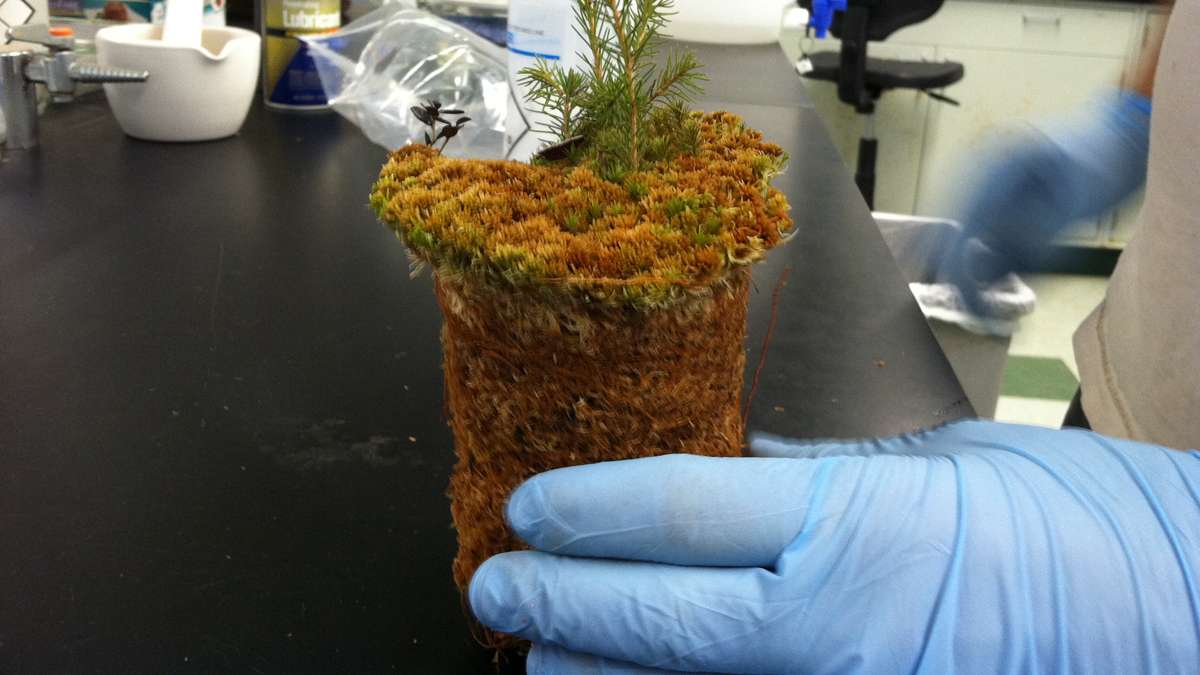Villanova scientists predict oil sands’ impact on peat, climate change
Listen-

-

A Villanova grad student holds a moss core with a black spruce in the lab (Laura Benshoff/for The Pulse).
-

-

Scientists study the impact of pollution on peat for clues about the future of Earth’s climate.
You may be familiar with peat from the garden section at your local Home Depot, but two scientists at Villanova University want you to think about peat globally – its relationship to climate change and its impact on your gas tank.
Peat is a brown, soil-like material consisting partly of decomposed vegetable matter.
“Each individual plant is really really tiny, but on a global scale, sphagnum – the genus of moss that forms peat – is probably more important than any other plant,” said Villanova Professor of ecosystem ecology, Kel Wieder.
That’s a big claim. Wieder and his colleague Melanie Vile, also a professor of ecosystem ecology, say peat and the mosses that create it are an important part of the global carbon balance, or the rate of exchange between carbon dioxide in the atmosphere and carbon “fixed” in soil.
“Peat bogs cover only about three to four percent of the earth’s land surface, but they contain about 30 percent of the earth’s soil carbon,” said Wieder. Most of the world’s peatlands are located in the northern hemisphere, in the boreal climate zone just south of the Arctic.
In Alberta, these areas overlap with the oil sands, a lucrative energy resource. Oil sands production increases pollution, putting more nitrogen and sulfur into the air. Pollutants which then fall as acid rain.
Vile and Wieder study the impact of this increased nitrogen on Northern Alberta’s peat bogs over time.
Science of moss
To understand how nitrogen affects peat, you need to delve into a little plant biology.
Sphagnum, the genus of mosses, are non-vascular plants – so they have no roots. They rely on rainfall and symbiotic microbes for nutrients. “They are like a big sponge essentially,” said Vile.
Moss, like all photosynthetic plants, needs nitrogen. But, unlike plants with roots, moss cannot directly absorb nitrogen that falls in rain and becomes “fixed” in soil.
But, more soil nitrogen is a boon to other types of plants. Plants that could shade out low-growing mosses.
Wieder and Vile have several control sites in Northern Alberta, sites unaffected by pollution, where they are able to introduce nitrogen and document ecosystem changes.
“We just completed our third season and we’re already starting to see a shrub response,” said Vile, shrubs which block the sun from low-growing mosses.
So more shrubs equal more shade – and maybe someday — less moss.
Back to all that carbon
“Very few ecosystems have done such a good job of taking carbon dioxide out of the air, over thousands of years, and storing it as soil, as peat bogs have,” said Wieder. Peat bogs are carbon “sinks,” ecosystems that store more carbon than they release.
Estimated to be around 7,000 years old, the world’s peatlands have been storing carbon since glaciers receded after the last ice age.
That carbon fixation is crucial for maintaining Earth’s temperature. “If we took all of that carbon that’s now in peat and put it back in the atmosphere, we would increase the carbon dioxide concentrations by at least 50 percent and the world would be a very warm place,” said Wieder.
But some oil companies are trying to put back what Wetland reclamation efforts by two oil companies dug up in their experimental stages.
Jonathan Price, Professor of Geography and Environmental Management at the University of Waterloo, works in peatland restoration and reclamation. He is a part of a team working on a former Suncor mining site, attempting to reintroduce peat and other plant life.
Price and the team at Suncor harvested plant life from a “donor site” and distributed it over the pilot area, a process called surface layer transfer. The planting finished last May.
“The material that has been transferred seems to be doing well, but I have to caution that it’s still early in the process,” said Price.
In the meantime, the area of peatland affected by tar sands mining continues to grow.
WHYY is your source for fact-based, in-depth journalism and information. As a nonprofit organization, we rely on financial support from readers like you. Please give today.



